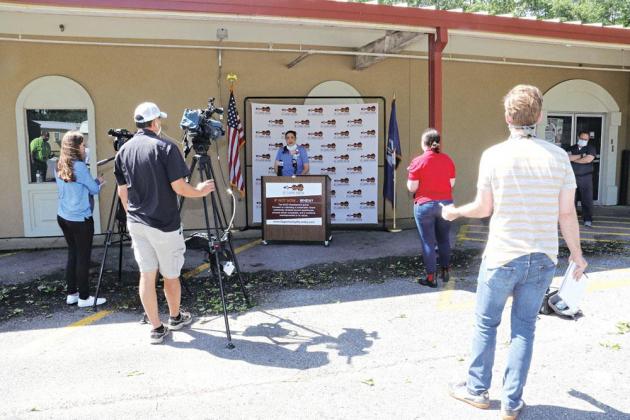
Harlan Kirgan
An Easter weekend news conference in Opelousas was about telling people to stay home during a time when family and friends normally gather.
After the weekend, Gov. John Bel Edwards said it appeared to him many people failed to heed the message to stay home to help flatten the coronavirus infection rate.
The news conference organized by Van Reed, St. Landry Parish director of emergency preparedness, included administrators from Opelousas General Health System, Opelousas Mayor Julius Alsandor, economic development official Bill Rodier and a handful of news people.
One indication about how serious the virus situation has become was that most of those in attendance were wearing face masks.
Ken Cochran, president and CEO of Opelousas General Health System, repeated the message about the need to stay home to avoid the transmission of the virus.
The hospital has 20 to 30 patients infected with COVID-19
Jackie Semien, chief nursing officer, said the patient count from the virus represented about 30% of the normal census.
The trend shows the strategy of social distancing is working, Cochran said.
But he also said with increased testing the number of COVID-19 positives will increase.
About 25% to 33% of the hospitalizations are into the intensive care unit, he said.
“They are sick, very very sick and are in a room by themselves with limited exposure even to our own staff,” he said.
The hospital converted its 16-bed ICU unit into a negative pressure area. Twenty-five rooms on the hospital’s fourth floor also have been converted to negative pressure areas. The hospital is adding more negative pressure rooms on its fifth floor in anticipating more COVID-19 infected patients.
Cochran said the hospital’s operating room has been divided into two areas, one with the negative pressure to filter out virus, bacteria and other particles.
“This feels like it is going to be somewhat of a new norm for us. So, we are trying to do that in a structured way, in a progressive way so that when the day hits and we get overwhelmed then we are the most prepared we can be,” he said.
The hospital has been short of staff and some employees are being retrained to help.
“The number of patients that come in, it comes in streaks. We will have a day where we will admit five people to the intensive care unit who are all intubated and we will go a day that will admit a couple of patients to our ICU or to the floor,” he said.
“Part of the problem is they stay for a long time,” he said of the COVID-19 patients. “Normally, our patients stay two to two-and-half days. Now, they are staying eight to 15 days.”
A third of patients admitted are intubated, a procedure that involves using a tube to help someone breathe.
The number of virus cases reaching hospitals is expected to increase in the region, he said.
Semien said the average age of the virus patients is 52 with ages so far ranging from 34 to 98.
The staff has not been immune from the illness.
“We have over 15 staff that have had the virus that we are aware of,” Cochran said.
“In general, they are heroic,” he said of the staff.
“They are kind of like firemen. Firemen don’t run away from a fire, they run into the fire ... They come to work. They know they are exposing themselves. They know the are exposing their families.”
Rodier, who said business owners and workers should make themselves aware of government assistance, also stressed social distancing while shopping.
“There will be an end to this if we all work together,” he said.
The coming days and the state’s daily report of infections will tell wether the social distancing over the Easter weekend happened or not.
